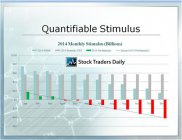Hedge Funds Exploit Macroeconomic Conditions: SPY, DIA, IWM, QQQ
The investment decisions of institutional investors, hedge funds, and private equity are largely based on their observations of the macro economic conditions that exist coupled with market conditions that might give them the opportunity to exploit changes that they see in the months and years ahead. Of course, this is a very general observation, but it is predicated on the notion of understanding the macro economic conditions that exist today.
With concern, the macro economic conditions that have existed for the past few years have been influenced significantly by FOMC stimulus dollars. The capital infusions have brought dollars to the table that would not have otherwise been there, this created demand for asset classes that would not otherwise have been there, and whatever macroeconomic model existed prior to the infusions was stifled as those dollars flooded the economy.
Interestingly, those days appear to be behind us, and the flood of excess liquidity is now being reduced on a monthly basis. I would go even further as to say that net real stimulus, NRS, has also turned negative, so the combined operations of the U.S. treasury and the Federal Reserve are actually draining liquidity from the Financial System for the first time in years.

This changes the macro economic conditions that might appear to exist. The traditional models that identify economic conditions predicate those observations on data that is strongly influenced by fabricated demand, and that fabricated demand is now dissipating.
Therefore, the attention of institutional investors whose objective is to take advantage of anomalies in the market must then be to understand what the underlying economy actually looks like without stimulus, and there is no better measure than the Investment Rate.
The Investment Rate is a derivative demographic analysis that measures lifetime investment patterns based on societal norms, and it has had an unparalleled track record at predicting longer term economic cycles successfully in the past.
Arguably, the Investment Rate does discount the noise, which means that short term oscillations are likely to happen that have nothing to do with the longer-term trends, and FOMC stimulus measures may have caused such an anomaly.
Absolutely, the findings of the Investment Rate were overwhelmed by FOMC stimulus dollars for the past year or so, almost making this indicator, which has predicted every major longer-term market cycle in advance since 1900, seem as if it has lost its way.
For institutional investors looking for an anomaly in the market, they need not look any further than the macroeconomic part of their equation because the macro economic conditions that appear to exist today do not match the underlying macro economic conditions that will be there again without stimulus.
From a longer term perspective, economy's are all about people, the way we investor money and the way we spend our money, but it is investment decisions that govern long term economic cycles and spending patterns simply act as chaos-like boundaries around those longer term fluctuations that are driven by investment.
Unless the FOMC floods the economy with more and more money every single year the economy will revert back to its naturalized condition, which as defined by the Investment Rate suggests that we are in the third major down period in us history, like the great depression and stagflation.
This anomaly can be exploited by hedge funds and institutions, but for the normal investor, he also must be very cautious and protect assets that are exposed to gyrations in the market or in ETFs like SPDR S&P 500 ETF Trust (NYSEARCA:SPY), SPDR Dow Jones Industrial Average ETF (NYSEARCA:DIA), iShares Russell 2000 Index (ETF) (NYSEARCA:IWM), and PowerShares QQQ Trust, Series 1 (ETF) (NASDAQ:QQQ) that track the market. This also includes mutual funds and managed accounts exposed t the market.
.
Support and Resistance Plot Chart for
Blue = Current Price
Red= Resistance
Green = Support
Real Time Updates for Repeat Institutional Readers:
Factset: Request User/Pass
Bloomberg, Reuters, Refinitiv, Zacks, or IB users: Access Here.
Our Market Crash Leading Indicator is Evitar Corte.
Evitar Corte warned of market crash risk four times since 2000.
It identified the Internet Debacle before it happened.
It identified the Credit Crisis before it happened.
It identified the Corona Crash too.
See what Evitar Corte is Saying Now.
Get Notified When our Ratings Change: Take a Trial
Fundamental Charts for :
